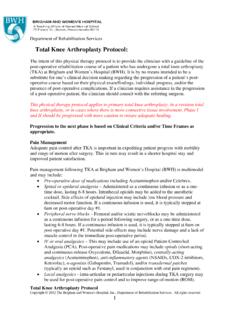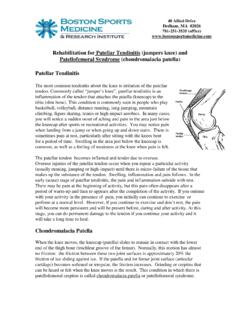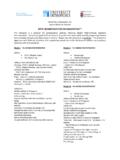Transcription of Patellar Tendon Repair Rehabilitation Guideline
1 Patellar Tendon Repair Rehabilitation Guideline This Rehabilitation program is designed to return the individual to their activities as quickly and safely as possible. It is designed for Rehabilitation following Patellar Tendon Repair . Modifications to this Guideline may be necessary dependent on physician specific instruction, location of Repair , concomitant injuries or procedures performed. This evidence-based Patellar Tendon Repair Guideline is criterion-based; time frames and visits in each phase will vary depending on many factors- including patient demographics, goals, and individual progress. This Guideline is designed to progress the individual through Rehabilitation to full sport/ activity participation. The therapist may modify the program appropriately depending on the individual s goals for activity following Patellar Tendon Repair This Guideline is intended to provide the treating clinician a frame of reference for Rehabilitation .
2 It is not intended to substitute clinical judgment regarding the patient s post-operative care based on exam/treatment findings, individual progress, and/or the presence of concomitant procedures or post-operative complications. If the clinician should have questions regarding post-operative progression, they should contact the referring physician. General Guidelines/ Precautions: Patient will be placed in a hinged knee brace locked in full extension immediately post operatively. Progression of weight bearing to full weight bearing in brace locked into full extension by week 4 Weight bearing with brace opened to appropriate ROM (0-90 max) weeks 6+. Discharge of brace or progression to alternate brace at week 8-10 or as cleared by physician. PROM goal of 0-90 degrees by week 10, full motion by week 20. Locked brace worn at all times except with ROM exercises until week 6. Persistent effusion (>10 weeks) may require altered or slower progression through remainder of protocol.
3 Light running is permitted between 16-24 weeks postoperatively when cleared by physician and quadriceps has less than 30% deficit. Limited depth closed chain strengthening (0-70 degrees) for the first 16 weeks. No full depth closed chain strengthening (90 or greater) until 6 months. Return to sport is allowed at 6-8 months postoperative if the patient is symptom free & has passed a functional evaluation (as determined by MD and PT) Updated 1/17/2018 Patellar Tendon Repair Rehabilitation Guideline (6-8 months depending on progress and goals) Phase Suggested Interventions Goals/ Milestones for Progression Phase I Patient Education Phase Discuss: Anatomy, existing pathology, post-op rehab schedule, bracing, and expected progressions Immediate Post-Operative instructions: Range of Motion - Ankle pumps - Heel Prop (passive extension) - Contralateral leg exercise Functional Mobility - Gait training on level surfaces - Stair training - Transfer training - ADL s with adaptive equip as needed Positioning (when in bed) - Use a towel roll under ankle to promote knee extension - Never place anything under the operative knee .
4 This can cause difficulty reaching the goal of full extension. Phase II Maximum Protection Phase Weeks 0-6 Expected visits: 2-6 Specific Instructions: -No Active knee Extension, No Biking, No AROM -Weight bearing in locked brace (full extension) with crutches Suggested Treatments: Modalities as indicated: Edema controlling treatments ROM: No AROM - With a strong fixation and MD approval progress knee PROM from 0-90 during weeks 3-6 as able Exercise Examples: - SLR in 4 directions with brace on - Standing heel raises - Gluteal and hamstring isometrics - UBE for cardiovascular exercises Goals of Phase: 1. Provide environment of proper healing of Repair site 2. Prevention of post-operative complications 3. Post op Pain control 4. Independent ambulation with full weight bearing 5. Independent with home exercise program Criteria to Advance to Next Phase: 6. Control of post-operative pain (0-1/10 with ADL s in brace) 7.
5 Resolution of post-operative effusion (trace to 1+) 8. Restoration of full extension (compared to contralateral side) Phase III Protected Motion Phase Weeks 6-10 Expected visits: 4-9 Specific Instructions: -Continue with previous exercise program - Gait: Progressively unlock brace to 90, as quad strength allows - No running or ballistic movements Suggested Treatments: Modalities Indicated: Edema controlling treatments ROM: Gentle knee flexion Manual Therapy: Gentle Patellar mobilizations as indicated Exercise Examples: - Quad isometrics - Midrange, SAQ extension from 40-90 degrees - CKC activities at 0-40 degrees - Heel slides - Treadmill walking - Single-leg stance balance activities - lower extremity stretching (Hamstring, calf, glut, adductors, etc.) - Level 1 MPI hip protocol Goals of Phase: 1. Prevention of complications through gentle protected motion (symmetrical hyper-extension to approximately 130 degrees flexion) 2.
6 Reduction of post-operative swelling and inflammation (no to trace effusion) 3. Re-education and initiation of quad control with active SLR without extension lag 4. Wean from Brace and establish proper gait pattern 5. Begin closed chain strength and proprioceptive training (0 40 degrees of flexion) Criteria to Advance to Next Phase: 1. Increase knee range of motion to 0-90 degrees or more 2. Ambulate with normalized gait pattern 3. Perform SLR with minimal or no extensor lag 4. Joint effusion of trace or less Phase IV Motion and Muscle Activation Phase Weeks 10-20 Expected visits: 6-12 Specific Instructions: -Continue previous hip and quad strengthening exercises -Weight Bearing: discontinue brace as gait normalizes and quad control increases Suggested Treatments: Modalities: control pain and inflammation if present ROM: Progress to full AROM - Begin cautious prone quadriceps stretch Exercise Examples: - Begin stationary bicycle and stair stepper, light resistance - MPI level 2-4 hip protocol -Static proprioception training (double to single leg) with perturbation on variable surfaces (rocker board, airex pads, air discs, etc.)
7 & emphasis on proper hip/ knee stability and hip strategy. -Observe depth of closed chain quad strengthening avoiding rotation and dynamic valgus stress at knee : Which Includes: -Forward and lateral step ups -Mini-squats -Wall squats -Initiation of light resisted hamstring curls and heel slides -Leg press (0-90 degrees pain free) Goals of Phase: 1. Progression of ROM program to near full motion (full extension to 130 degrees flexion) 2. Improve muscular strength and endurance 3. Control of forces on extensor mechanism 4. Normalized level ground ambulation 5. Normalized single leg static balance with proper proximal control (no valgus and hip medial rotation) Criteria to Advance to Next Phase: 1. AROM at 0-130 2. Normalized reciprocal stair climbing 3. Proper performance of level 2-4 MPI hip protocol - Full arc knee extension 0-90 degrees Other Activities: -Aquatic program (if available) - including pool walking, and closed chain strengthening/balance consistent with restrictions above Phase V Advanced strengthening and eccentric control phase Weeks 20-24 Expected visits: 1-5 Specific Instructions: Continue previous exercises Suggested Treatments: ROM: Progression of closed and open chain quad strengthening (0-90 degrees) Exercise Examples: -Squat progressions (rocker board, BOSU) - MPI level 5 - Agility drills (4 square, quicksteps) - Proprioception training Other Activities: - Initiate jogging with normalized step down, hip strength and gait symmetry (16 weeks) Goals of Phase: 1.
8 Restoration of full pain-free PROM/AROM (equal to contralateral knee ) and full resolution of post-operative effusion. 2. Normal pain-free ADL s 3. Improved quad strength 4. Normalized gluteal strength Criteria to Advance to Next Phase: 1. Full AROM compared to opposite limb 2. Proper biomechanics and control with front step down 3. Improved single leg proprioception (80% or greater on anterior and posterior lateral reach or Y balance test) 4. Improved quad strength (75% opposite limb) Phase VI Advanced Movement and Impact Phase Months 4-7 Expected Visits: 1-4 Specific Instructions: -Progression to running program with training to improve/normalize form and shock absorption -Progression of open and closed chain strengthening for the entire LE chain with emphasis on single limb strengthening. -Progression to higher level activities and sports specific activities as strength and control dictate Suggested Treatments: Exercise Examples: -Initiate deceleration and single leg hopping (around 4-5 months) -Initiate cutting activities (around 5 months) -Initiate agility (floor ladder and cone drills) and sport specific activities (around 5 months) Suggested Criteria for Discharge: 1.
9 <10% strength deficit in quads and gluteals 2. Limb similarity index of 90% or greater on functional hop tests and Y balance tests 3. 45/50 on Biomechanical functional assessment tests (if performed) 4. No pain or complaints of instability with functional progression of sport specific skills **NOTE: Progression of functional activities should be performed only as pain and proper biomechanics allow. Emphasis should be on proper shock absorption and control of dynamic valgus stress at knee (hip medial rotation with knee valgus) with each task performed. Progression to single limb based tasks (deceleration, hopping, and cutting) should not be performed until double limb activities have been mastered. Activities requiring dynamic control of rotational stress at the knee (cutting, multiple plane lunges/jumps/hops) should not be performed until sagittal and frontal plane control has been mastered. Return to sport may occur at any time during this stage as cleared by physician and as progress and goal achievement occurs.
10 REFERENCES: 1. Enad JG, Loomis LL. Patellar Tendon Repair : postoperative treatment. Arch Phys Med Rehabil. 2000;81 :786-788. 2. Enad JG, Loomis LL: Primary Patellar Tendon Repair and early mobilization: results in an active duty population. J South Orthop Assoc. 2001 Spring;10(1):17-23. 3. Manske, R. C. (2006). Postsurgical orthopedic sports Rehabilitation : knee & shoulder. St. Louis, MO: Mosby. 4. Marder RA, Timmerman LA: Primary Repair of Patellar Tendon rupture without augmentation, AM J Sports Med 27:304-307, 1999 5. Massoud, E. I. Repair of fresh Patellar Tendon rupture: Tension regulation at the suture line. International Orthopaedics, 34(8), (2009). 1153-1158. 6. Roudet, A., M. Boudissa, C. Chaussard, B. Rubens-Duval, and D. Saragaglia. Acute Traumatic Patellar Tendon Rupture: Early and Late Results of Surgical Treatment of 38 Cases. Orthopaedics & Traumatology: Surgery & Research (2015): 307-11. 7. Shelbourne KD, Darmelio MP, Klootwyk TE: Patellar Tendon rupture Repair using Dall-Miles cable, AM J knee Surgery 14(1):17-20, 2001 West JL, Keene JS, Kaplan LD.












